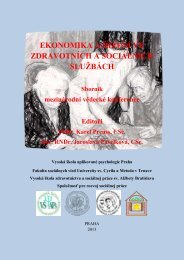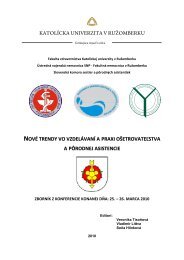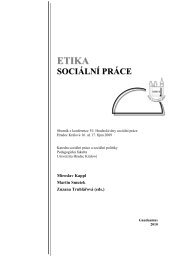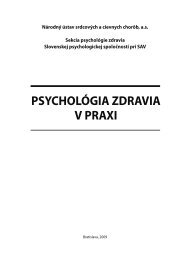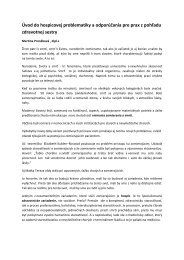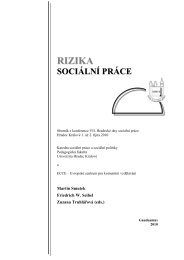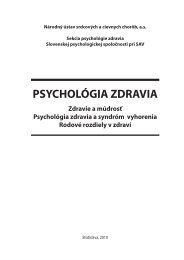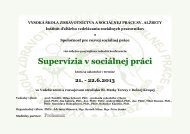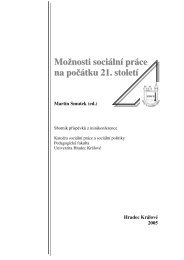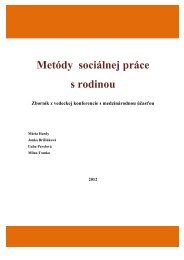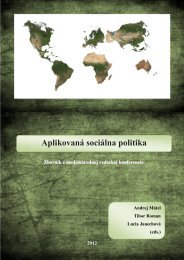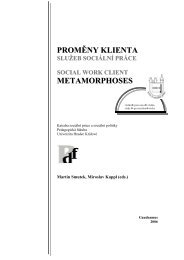Zmena klÃmy â možný dopad (nielen) na obyvateľstvo - Prohuman
Zmena klÃmy â možný dopad (nielen) na obyvateľstvo - Prohuman
Zmena klÃmy â možný dopad (nielen) na obyvateľstvo - Prohuman
You also want an ePaper? Increase the reach of your titles
YUMPU automatically turns print PDFs into web optimized ePapers that Google loves.
plateau cities then the HIV burden of this population is likely to be substantially<br />
higher, and will also be worsened by increased poverty and greater food insecurity.<br />
There are several other plausible biological pathways in the HACC. Of these, the<br />
relationship between CC, air pollution and immunity, and CC, heat stress and immunity<br />
are likely to be the most important. More speculative is the possibility that<br />
that CC will harm infrastructure and gover<strong>na</strong>nce on a scale sufficient to aggravate<br />
and prolong the BOD of AIDS. Again, the population of SSA is judged to be at the<br />
highest risk. This mechanism is plausible by interlinked pathways including more<br />
extreme weather events and “<strong>na</strong>tural” disasters, increased mobility and additio<strong>na</strong>l<br />
migrants and refugees. These factors are also likely to aggravate gender inequalities,<br />
increasing the frequency of transactio<strong>na</strong>l and coercive sex – pathways likely<br />
to increase the BOD of AIDS among women and girls, via increased viral transmission<br />
and reduced access to treatment and prevention. At the global level, CC<br />
may exert an immense opportunity cost, diverting resources of the inter<strong>na</strong>tio<strong>na</strong>l<br />
community away from public health, including from HIV, poverty alleviation, and<br />
the other Millennium Development Goals (MDGs).<br />
Suggestions for a future research agenda include the more accurate assessment<br />
of the pathways within the HACC, and an improved conceptual understanding of<br />
the linkages between conflict, behaviour, gover<strong>na</strong>nce and values, environmental<br />
factors including climate, and food production, and between each of these macro-elements<br />
and sea level rise. This would be the best done by an interdiscipli<strong>na</strong>ry<br />
working group. Another research gap is the effect of CC on human behaviour,<br />
including behaviour related directly to HIV risk.<br />
AIDS has already killed tens of millions of people, while CC may dwarf this<br />
number. Those concerned to reduce CC can apply many lessons learned by the<br />
AIDS community. These include the need to challenge conventions and to seek<br />
benefit for the poorest and the most margi<strong>na</strong>lised – and to widen the CC movement’s<br />
emerging engagement with intrepreneurs, philanthropists and prominent<br />
perso<strong>na</strong>lities: tools instrumental in the growth of support for those with HIV. The<br />
AIDS constituency can benefit from the experience of humanitarian programmes,<br />
some of which already see AIDS and CC as cross-cutting issues.<br />
Fi<strong>na</strong>lly, a risk is perceived whereby a relatively privileged stratum of people<br />
and interests argue that issues of global health and global social justice must be<br />
put aside in the effort to pursue partial CC adaptation. This approach is highly<br />
dangerous for global health and global social cohesion. It would also likely generate<br />
profound longer-term risks for currently privileged populations pursuing<br />
this strategy. A stronger alliance between the AIDS and CC communities will help<br />
thwart the emergence of such a policy. A focus on the interconnections between<br />
45




